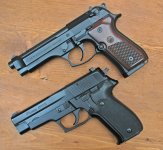Panasig45
Miembro de la Vieja Guardia
Los inicios:
Tomado de http://www.govexec.com/features/0604-15/0604-15s1.htm
Estas pruebas surgen de la necesidad de unificar las armas de las agencias integradas en el nuevo ministerio de seguridad Interior.
La innovación es que el arma tiene que ser comprada y probada en varios calibres a la vez.
La razòn era que los agentes usaban armas en distintos calibres en las agencias que se unieron,
Las pruebas iban mas allà de las pruebas XM 9, por ejemplo las armas tenian que hacer 10,000 tiros en lugar de 5000.
Tomado de http://www.govexec.com/features/0604-15/0604-15s1.htm
Estas pruebas surgen de la necesidad de unificar las armas de las agencias integradas en el nuevo ministerio de seguridad Interior.
It's a timely question, because agents from Customs, INS and the Air Marshals are now in the same agency, the Homeland Security Department's U.S. Immigration and Customs Enforcement bureau. And they're about to get new handguns. Since February, the world's top gun makers have been in a shootout for the right to sell handguns to ICE. In August, after extensive testing at federal armories in Pennsylvania and Georgia, ICE will pick one or more of them to arm its more than 12,000 law enforcement officers. In a novel arrangement, other agencies in the department also will be allowed to buy pistols through the ICE contract. Up to 45,000 gun carriers could get new weapons.
"This is the largest pistol procurement in the history of U.S. law enforcement," says Wayne Weber, a manager with the German firearms giant Heckler & Koch, one of the top-tier firms competing for the five-year, $25 million contract. Besides H&K, Austrian gun manufacturer Glock, Italy's Beretta, and two American-based manufacturers, Smith & Wesson and SigArms Inc., acknowledge vying for the pact. "We believe that most of the companies will lower their price to land such a large, important contract," says an executive with another of the gun manufacturers, who requested anonymity to speak candidly about the ongoing procurement.
La innovación es que el arma tiene que ser comprada y probada en varios calibres a la vez.
With so many different officers to arm, ICE and its Homeland Security overseers want to maximize their buying options. They are looking for a family of firearms - a .40-caliber, a .357-caliber and a 9 mm - in full/compact and subcompact form (subcompacts are popular with officers who have smaller hands and those who work undercover).
La razòn era que los agentes usaban armas en distintos calibres en las agencias que se unieron,
Agents from both camps wonder whether the bureau will use the procurement to switch its 6,000 agents to a common pistol: the Glock 9 mm used by Customs veterans, or the .40-caliber H&K carried by INS agents. "A lot of people feel this is the turning point," says a former Customs agent. "A lot of INS people want to stay with the .40 [caliber]. A lot of Customs people want to stay with the 9 mm. It's like, which agency are we going to placate?"
Las pruebas iban mas allà de las pruebas XM 9, por ejemplo las armas tenian que hacer 10,000 tiros en lugar de 5000.
At ICE firing ranges, Trotto is putting the pistols through one of the most rigorous testing regimens ever devised, gun manufacturers say. With the help of dozens of officers from CBP, the Coast Guard and the Secret Service, Trotto's team will fire ten thousand rounds with each model. The guns get beat up; they are put in a 200-degree oven for eight hours and dropped on concrete. They are dunked in salt water and sprayed with sand. "We put the [guns] through the wringer to find out what their real performance capabilities are," says Trotto.



